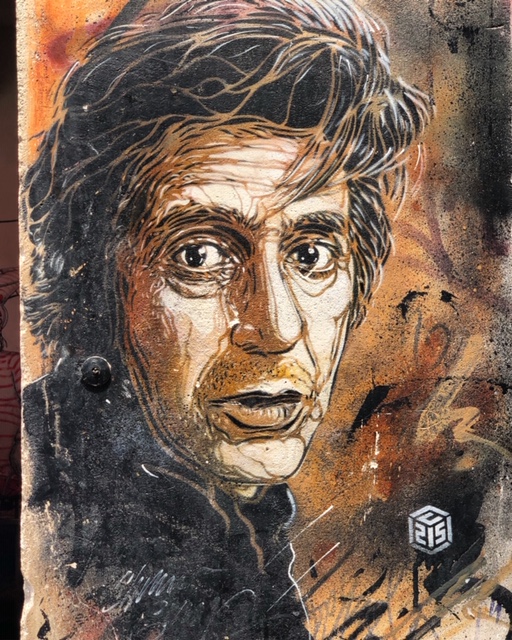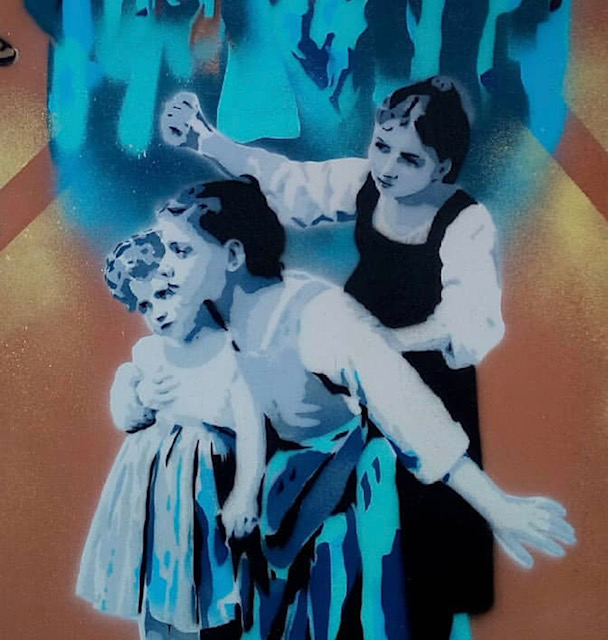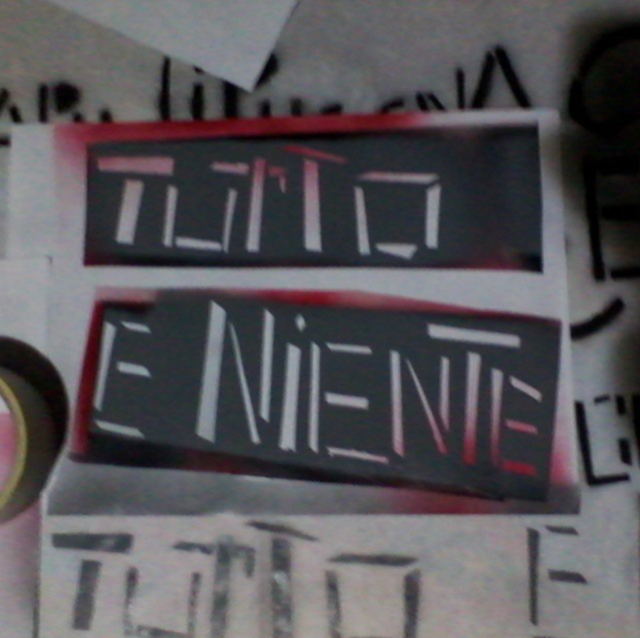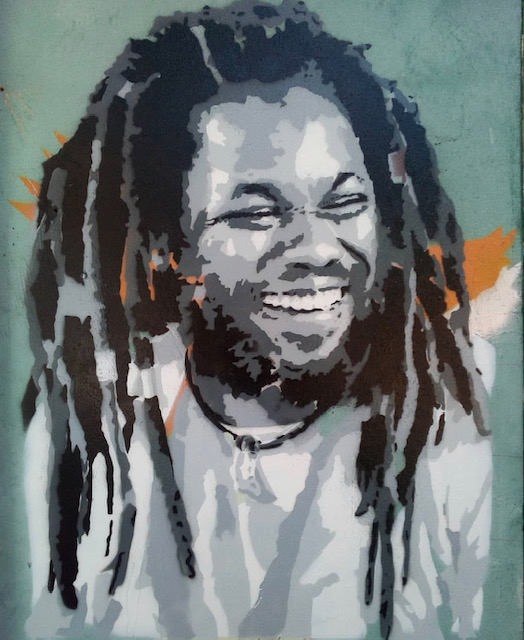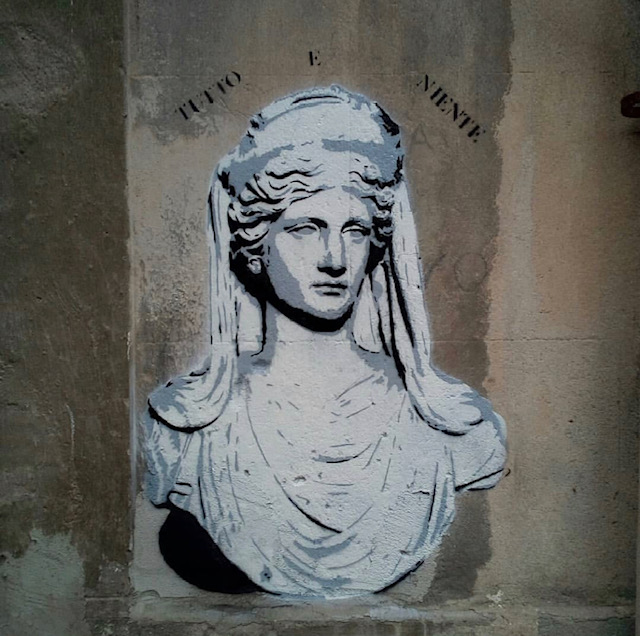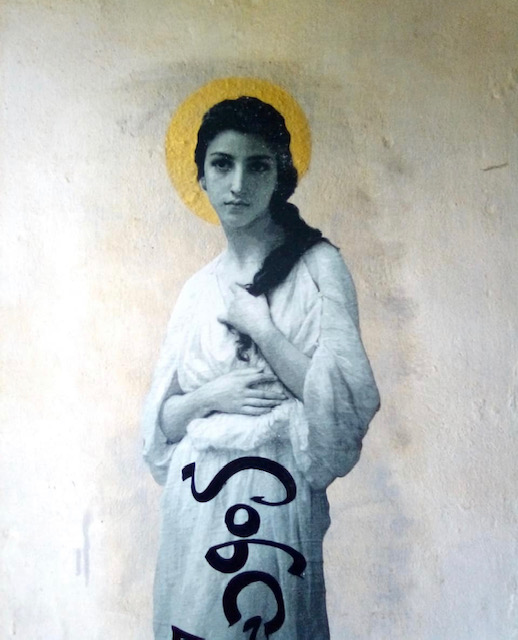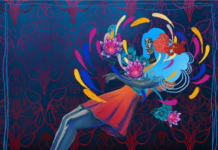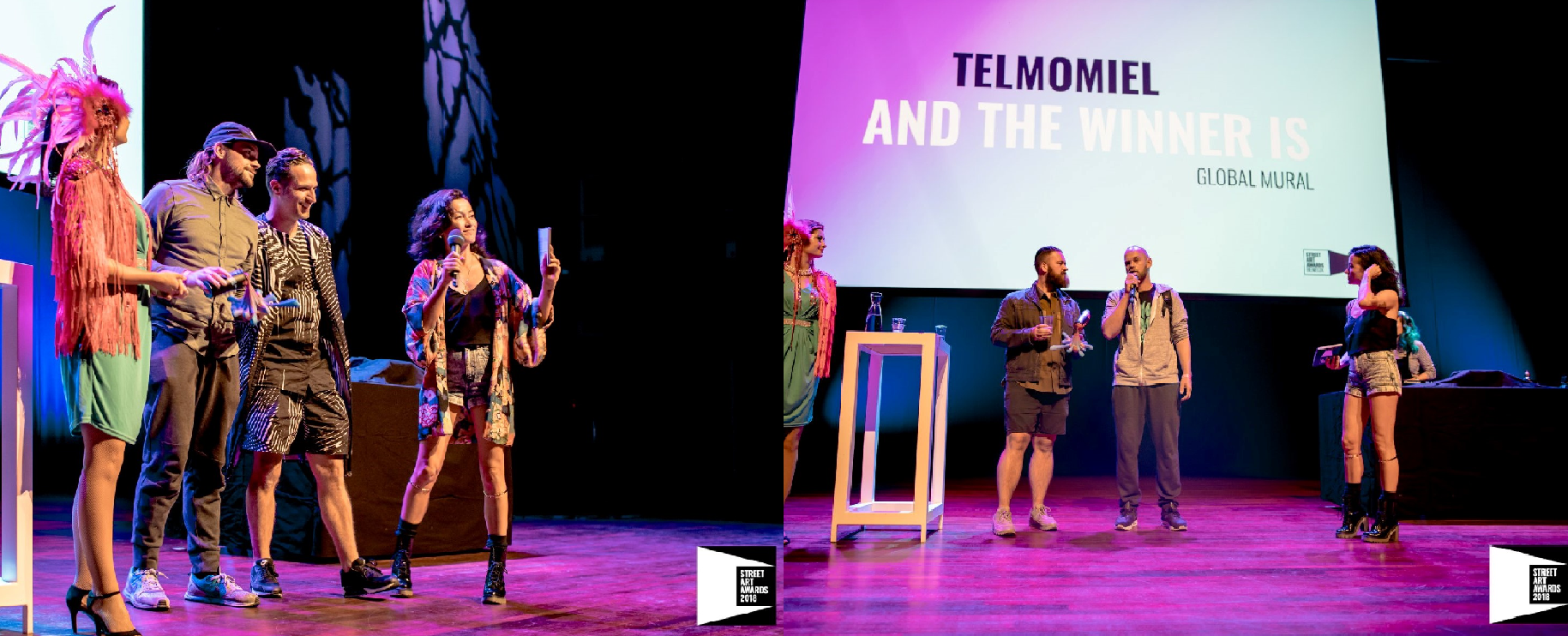As you walk past the houses in the streets of historic Palermo, their windows protected from burglars by iron bars, you can feel you’re getting close. In Palermo Street Art can be found everywhere, but especially at the Mercato Ballarò. Over the past years, international street artists have made the neighborhood into an attraction for Street Art enthusiasts and photographers.
But next to Christian Guémy’s Sicilian stereotypes – a beautiful portrait of Al Pacino and an image of Marlon Brando as The Godfather – one also encounters interesting local artists. To me, one immediately stood out: “Tutto e Niente”. Back in Holland we got in touch…
CC: First off, thank you for taking the time to tell us about Italian Street Art. For starters, could you tell us when graffiti culture took off in Palermo?
T&N: Modern graffiti, that is as an urban phenomenon, let’s say that since the end of the 70s different underground movements like punk and political movements came into being (both on the right and on the left). They began to use the method and language of graffiti to communicate ideas and to mark places of belonging. But the much more active and stylistically evolving scene of graffiti art manifested itself at the beginning of the 90s, especially also with the birth of local musicians that followed the Italian hip-hop scene.
CC: I have seen some of Palermo’s Street Art and loved it. What should we know about it?
T&N: The Street Art scene or the urban art of Palermo was born around 1990 with writings on the walls in Italian. In the early 2000s, you began to see different languages and other art forms than writing. You can find them in the city centre, suburbs and historic villages around Palermo.
CC: Where does the name “Tutto e Niente” come from?
T&N: Many years ago a person told me “you are Everything and Nothing. It’s up to you to know and to choose what you want to be”. It’s a name that suggests absolute freedom of choice, like everything between two extremes. “Everything” invites you to see whatever you want in the things that I leave around, and to consider whether it is part of a whole or of “Nothing”. I try to position myself between these two important words. I feel that the artist is often or almost always self-centered, and my pseudonym helps me to not aim for fame, but instead to live, to lose myself, and then to re-find myself trough my work.
CC: Can you tell me at what age you started to make art and why you chose the streets as your canvas?
T&N: We make art because we want to communicate. I was born in Palermo in 1982 and moved to Syracuse in 1988. It was there, as a kid, I started to draw wherever I played, with whatever was at hand: coal, tuff stones, chalk. In fact, I used to loose myself to such a degree in drawing on the walls of streets, of courtyards, of my room, on school desks, … let’s say I got scolded a lot.
In my adolescent years and while studying at the art institute of Syracuse, I began to look for different ways to get involved in this thing called “art”. I painted my scooters and friends asked me if I could paint the walls of their garage and I did it because it made me happy. It was a wonderful way to express myself.
At the age of 20, I returned to my hometown of Palermo and enrolled at its Academy of Fine Arts. I learned to move in what is called “artistic circles”, but I could not really find my place within the system. I did not feel the desire to attempt to emulate the professors or students who successfully moved within the particular art world. So after my academic career and after some experience in the artistic container, I decided to break out and choose the street as my canvas. The street became the place to speak my own language, only now with some more knowledge and technical skill.
Already as a boy, I think I realized that the street is what it is, without apologies. And since I was very suspicious of more ambiguous, more normative environments, I felt that the street was the only place where one could move about freely without necessarily striving for great goals or fame; where I could socialize with anyone, whatever their background. For me, the street was the best option, a canvas that is different each time but always open to the artist’s impulse and intuition. Speaking with the people of the neighborhood where I want to paint, starting without planning too much, the dialogue while I paint, the unforeseen outcome, being accepted by the district… I find having the opportunity to experience all that is the joy of life.
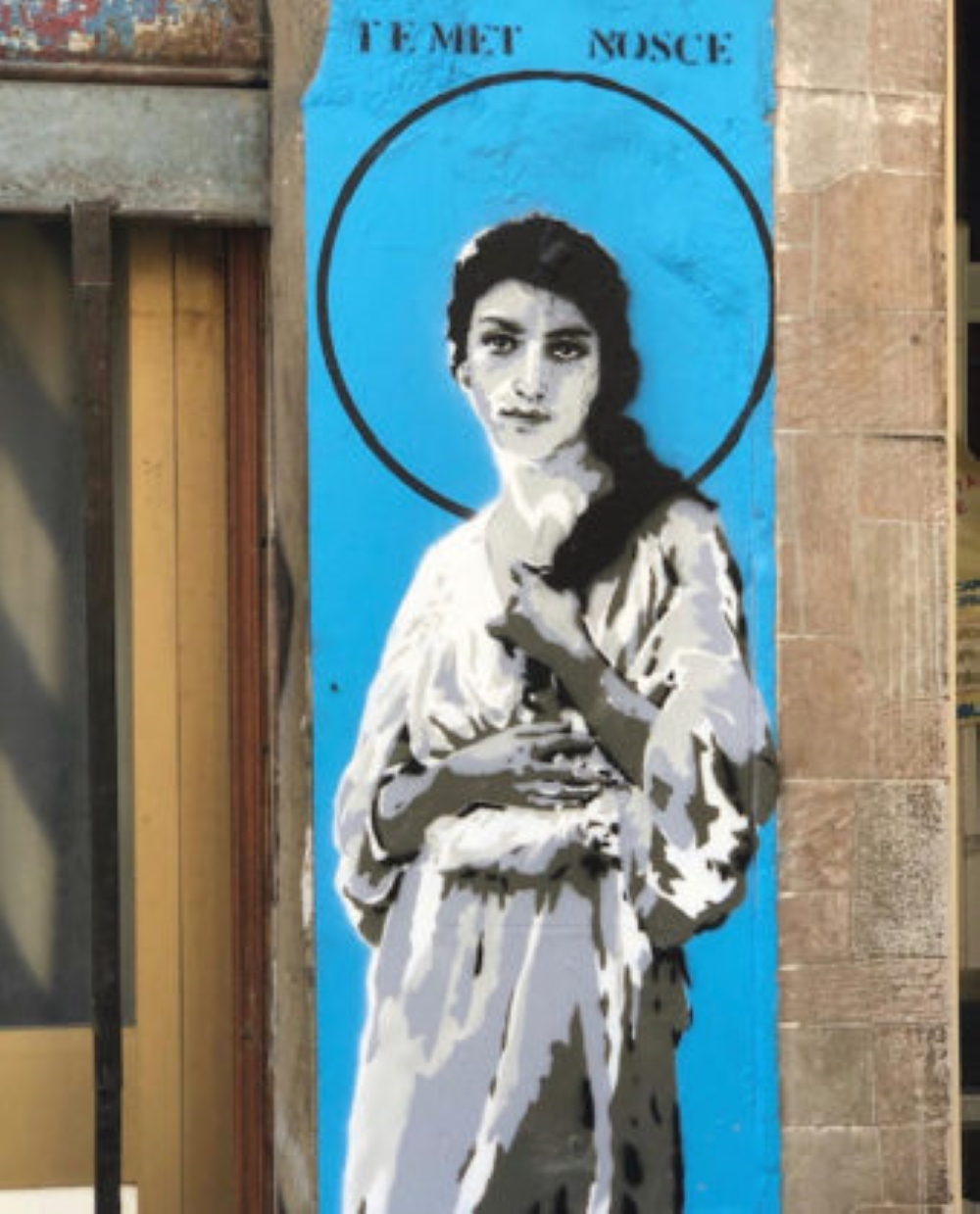
CC: How do you choose your subjects?
T&N: The subjects I choose very often relate to the feminine and to the maternal archetype. It derives from the fact that I was raised by women and especially by my maternal grandmother. As a child, she always pushed me to paint, or at least to improve my desire to communicate. What’s more, in the urban environment I work in, women are the managers and supporting pillars of the family. I also work with subjects that remind me of people I met on the street and who died. And there are the subjects related to integration and multiculturalism, our cultural and very real DNA – the people of Palermo have Arabic, Spanish and French blood running through their veins. Then there are the various degrees and interpretations of the sacred and the profane that form an important part of my hometown. I live where I paint, and my “logos” are how I try to bring everything together.
CC: Who are the people in your stencils, and what is your message?
T&N: The characters in my works are people I have known (portrait of Mosè, see below), women, men, historical figures, ordinary people, goddesses, saints, harlots, mothers, children, and also symbols.
The messages are diverse, but in the end they all revolve around femininity, motherhood, the creation of new life, sensitivity, mediation, and peace.
In the lives of the historical characters, including saints, that I represent, the actions and choices they make carry meaning. These messages have to be translated or decoded, and I leave this entirely to the observer. I will say these messages are always universally relatable, so that what is generally seen as “normal” becomes sanctified and what is regarded as “sacred” becomes normal. My messages are direct and indirect.
CC: Who is Rosalia?
T&N: Rosalia, in the popular and Catholic Christian tradition, is the patron Saint of the city of Palermo: Rosalia de S’inibaldi, 1130 – Palermo, 4 September 1170. The story says that in 1625 the Saint saved Palermo from the plague.
In my work Rosalia is foremost a noble woman who threw off her riches and chose the life of a hermit. In my reinterpretation, Rosalia looks like any other girl with a very Mediterranean appearance; with a very obvious feminine beauty but at the same time so strong and conscious that it radiates a lucidity and balance that seems reserved to the feminine.
CC: Are there other subjects that are so typical for Palermo?
T&N: Sure, at the end of the 70s and the beginning of the 80s the writing on the walls was mostly political. It became a means to protest against the Mafia, which is of course a typical subject for the region. At the beginning of the 2000s individual artists begin to stand out and various idioms begin to evolve, dealing with different social topics.
CC: Do you only make stencil art, or do you also use other techniques associated with the Street Art movement?
T&N: I use different techniques, mixing them together. The specific mix depends on the surfaces where I choose to intervene. I often use waste or objects that I find, then rework them and then place them back where I found them. I work with different pictorial techniques, but I never use technology like scale enlargement programs such as photoshop, projectors or cutting plotters. I always work manually. Let’s say that I remain loyal to the “primitive” side of artistic creation. I mostly work with a hardcore handmade stencil technique, and I mostly work nights because my offspring 😉 doesn’t leave me much spare daytime.
CC: Can you describe the elements that make up a typical Italian style?
T&N: I believe the canons are fundamental to what you can call a true Italian style. Every region in Italy has a different historical baggage and this, directly and indirectly, affects the artists from that region. This is visible in the themes and styles that are used. The connecting or distinctive aspects of a place are also united in art.
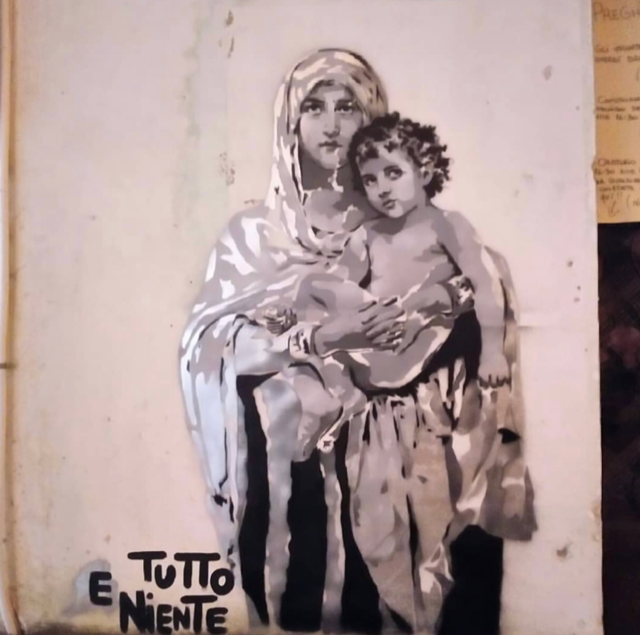
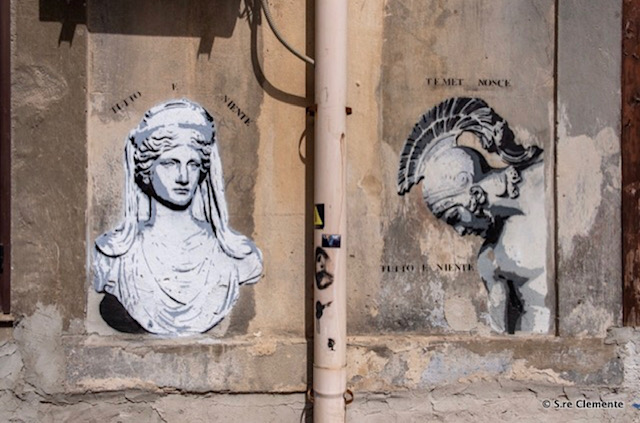
Just think about how Pop Art was born in America in the 1960s and at the same time in Italy and in response to this the “Arte Povera” emerged. Two different manners and dialectics, which across all their differences are nevertheless related.
CC: Is there a difference between Italian and Northern European Street Art?
T&N: As I said before, I believe that the differences are there. Both because of the person of the artist and because of the places they are from. Northern European Street Art has a much wider range of action. The artists come from a larger tradition and quite literally have more space. Through Street Art relatively new urban spaces and environments are improved. Italy is a very old country, with old cities, and that often makes it more difficult to work on different (large) surfaces.
Paradoxically, Italy is seen as the birthplace of European culture but it has a fairly closed attitude to new developments (Street Art).
CC: Do you only work in Palermo or do you also work in other parts of Italy or even other countries?
T&N: I work in Sicily and specifically in Palermo. I love being free to intervene in the depths of the city, interacting a lot with the inhabitants and deciding together where to be able to intervene, which will mostly be in relatively abandoned or degraded places. I work without commissions. My patrons are the inhabitants, often humble workers, and their enthusiasm is my reward.
CC: What is your dream, when it comes to making art?
T&N: My dream when it comes to making art is making art as long as I live!
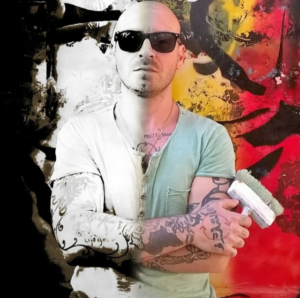
CC: Last but not least, are you a male or female artist…? I am very curious!
T&N: I’m a male artist, but very feminist 🙂
CC: Is there a question I didn’t ask, you think I should have asked?
T&N: Whatever questions you asked me, they came from you, and so I have to accept them and not add my own. I fully embrace all those you have asked me as well as those you have not posed! 😉



